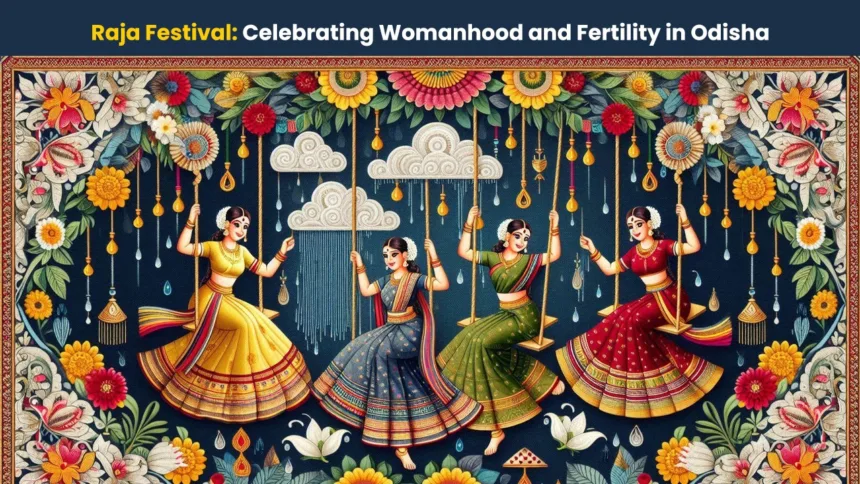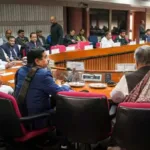The Raja Festival, pronounced as ‘Ro-jo‘, is one of the most vibrant and significant celebrations in Odisha, a state on the eastern coast of India. Spanning over three days, this festival is dedicated to celebrating womanhood, fertility, and the advent of the monsoon season. This year, the Raja Festival will be observed from June 14th to June 16th, with preparatory rituals starting on June 13th.
Origins and Historical Significance
The Raja Festival is deeply rooted in the agrarian culture of Odisha. The term ‘Raja‘ is derived from the Sanskrit word ‘Rajas‘, meaning menstruation. The festival aligns with the menstrual cycle of the earth, symbolizing fertility and the renewal of the soil with the onset of the monsoon. According to folklore, this period marks the menstruation of Mother Earth (Bhuma Devi), and just as women rest during their menstrual cycle, the earth is given a similar rest before the agricultural activities commence.
Historically, Raja Parba has been celebrated since ancient times, reflecting the region’s respect for nature and the feminine. It is believed that the festival also has connections with the worship of Basu Mata, a form of Mother Earth, where people sought her blessings for a bountiful harvest.
More Read
Celebrations and Rituals
The festivities of Raja are marked by various customs and rituals that highlight the cultural richness of Odisha:
Pahili Raja (First Day): The festival kicks off with Pahili Raja. On this day, women and girls are relieved from their daily chores, symbolizing rest during their menstrual period. They adorn new clothes, apply alata (red dye) on their feet, and wear traditional jewelry. Special attention is given to cleanliness and personal hygiene, emphasizing the importance of self-care.
Mithuna Sankranti (Second Day): This day marks the beginning of the solar month of Mithuna, when the sun transits to the zodiac sign of Gemini, heralding the monsoon. It is the most important day of the festival. Women wake up early, bathe, and partake in community prayers. Various games and swings are set up for amusement, and people enjoy traditional foods.
Basi Raja (Third Day): The third day, Basi Raja, continues the festivities with similar enthusiasm. By this time, the rain is expected to have softened the soil, preparing it for agricultural activities. Women engage in folk songs and dances, celebrating the joy and rejuvenation that the rains bring.
Vasumati Snana (Fourth Day): The festival concludes with Vasumati Snana, a ritual bath of Bhuma Devi. Images of the deity are given a ceremonial bath with turmeric paste, symbolizing purification and prosperity.
Traditional Foods and Attire
Food plays a significant role in the Raja Festival. Special delicacies like Poda Pitha, a slow-cooked rice cake made with jaggery and coconut are prepared and shared among family and friends. The food reflects the agricultural abundance and culinary heritage of Odisha.
Women and girls dress in vibrant sarees and traditional attire, enhancing the festive spirit. Swings, or ‘dolis‘, are a prominent feature, decorated with flowers and set up on large trees, providing joyous rides and symbolizing the fun and relaxation associated with the festival.
Cultural and Social Significance
Raja Festival is more than just a celebration; it is a social phenomenon that promotes gender sensitivity and environmental awareness. By associating menstruation with the fertility of the earth, the festival destigmatizes a natural biological process and venerates the feminine. It also underscores the critical relationship between human life and nature, advocating for sustainable agricultural practices.
Moreover, Raja fosters a sense of community and togetherness. Villages and neighborhoods come alive with collective participation, strengthening social bonds and cultural continuity. The festival also provides a platform for young women to express their creativity and partake in various cultural activities, reinforcing their role in the community.
In essence, the Raja Festival of Odisha is a beautiful amalgamation of tradition, culture, and nature. It celebrates the essence of womanhood and the earth’s fertility with joyous festivities, rich rituals, and a deep respect for both women and the environment. As the monsoon clouds gather, the people of Odisha come together to honor these timeless values, making Raja a cherished and enduring part of their cultural heritage











